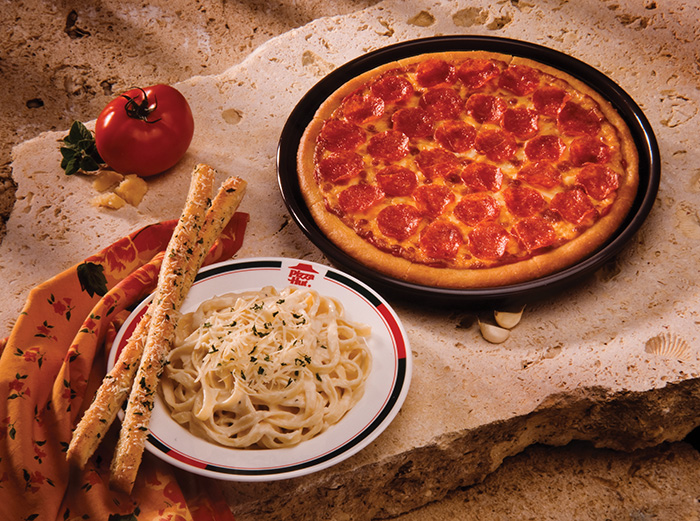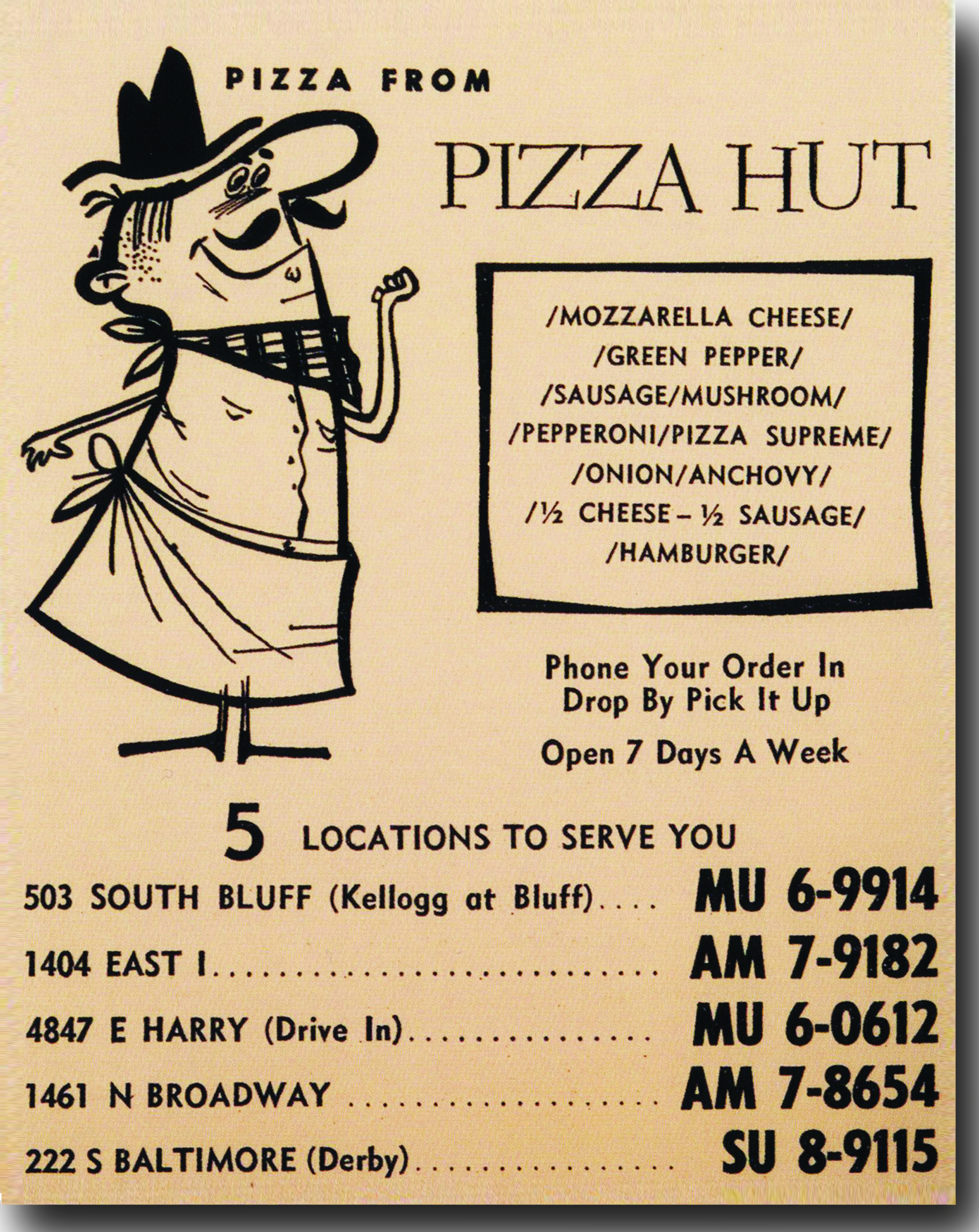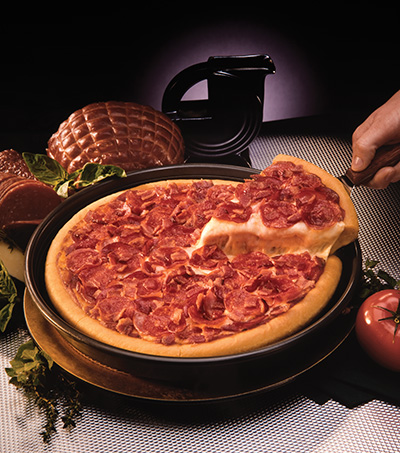A funny thing happened to Dan and Frank Carney on their way to business degrees at Wichita State University. Both were sidetracked, at least temporarily, by the chore of building an international business empire.

The Carneys’ business didn’t start out big, of course, just as a tiny, 25-seat pizzeria behind their father’s grocery store at Kellogg and Bluff. As Pizza Hut celebrates its 50th anniversary, now with more than 10,000 restaurants in more than 100 countries, the brothers look back on their days as part-time students, part-time entrepreneurs with satisfaction.
“I was writing a master’s thesis on collective bargaining at the time,” says Dan Carney, speaking at an office full of intriguing Pizza Hut memorabilia on North Rock Road. “They wouldn’t let me write on franchising.”
Like all of Michael and Mary Frances Carney’s children, Dan’s and Frank’s business education began early in their family’s Carney’s Market, doing odd jobs and, as soon as they were old enough to get a driver’s license, making deliveries. As the oldest of the children, Dan was largely responsible for the operation of the store after his father’s death, even as he earned a bachelor’s degree in business administration at the University of Wichita, as it was then called.
Dan Carney continued to learn about business while serving in the Air Force in Georgia, where he read everything he could find about the burgeoning McDonald’s and Kentucky Fried Chicken chains and their new-fangled franchising plans.
When he returned to WSU to pursue a master’s degree, while raising a family and working at Boeing as well as Carney’s Market, Carney found that his big idea was too new for the professors. Still, he found that his formal education came in handy.
“What the degree does, what it gives you most, is it teaches you how to think,” Carney says. “At that time, there were no courses on franchising. In fact, franchising was pretty much relegated to the auto business at that time.
"Still, it gave me the background to form my own company, and basically our own franchise agreement, which evolved over time. Today you have entrepreneurship classes, and all kinds of different courses that would pretty much give you the basic background to go into business for yourself.”
Although the Carneys were already in business for themselves with the family grocery store, Dan and brother Frank, who was seven years younger and a sophomore studying mathematics at WSU, decided to get into the restaurant business. The official story told in “The Pizza Hut Story,” a history of the chain that comes in its own pizza box, is that the suggestion to try pizza came from their market’s landlady, who had read about the emerging fad for the food in The Saturday Evening Post and was eager to find a new business to replace the slightly seedy bar and grill whose building she owned next to the store.
Frank Carney recalls more prosaic reasons for trying pizza. “I think my brother really has the stripes on that one, he was the one who decided,” Frank Carney says. “He had eaten pizza, there were a couple of pizza places in Wichita, we liked the product and all the college students liked that product.
It was what was new, and KFC and McDonald’s had done chicken and burgers.” In any case, with $600 borrowed from their mother, and some help from a friend of their sister, the brothers moved into the hut-shaped building next to the grocery store and got to work.
“We found a guy from Indiana that was an airman at McConnell, who lived at the same apartment complex as our sister and brother-in-law, and we talked with him, because we didn’t know how to make pizza,” Frank Carney says.
“He said he had some great pizza. His name was John Bender. We had him over, he made pizza, and we liked it. We said ‘If you bring the recipe, you can have a full-time job here with whatever time you can get out of the air base, and a third of the business.’ He did, and it went from there, and that’s where we got our pizza.”
The original Pizza Hut was one of only two places that offered pizza in Wichita in 1958, the other being an Italian restaurant, and local demand for the product proved bigger than their small hut of a building. Soon the brothers were building other Pizza Huts around their hometown. “The first one cost about $600 to open — this was in 1958, and money was different — and our real plan was that as soon as we could pay off the $600 and open another we would do it,” Frank Carney recalls. “That was automatic. The franchising didn’t open until later. We had six stores in Wichita, and wondered how to develop, so my brother studied franchising a lot."
Brother Dan’s office is a veritable trip down memory lane for any Wichitan old enough to recall the days when Pizza Hut’s six stores dominated the local pizza market. On the wall are all manner of memorabilia featuring “Pizza Pete,” the apron-clad, pizza-shoveling mascot of the old-time stores, created by WSU’s Ed Pointer.
There are also menus from the original location, with a large supreme selling for $2.50, proving that money really was different then, and hand-written work schedules for the first restaurant, which Dan Carney proudly notes already included plans for a second one. There’s even the original sheet music for the “Putt Putt to the Pizza Hut” jingle that rattles in the mind of many a Wichitan.
Testifying to the rapid growth of the Carney’s enterprise are Barbie dolls and Matchbox cars with the Pizza Hut logo, as well as items related to the first restaurants opened in such far-flung locations as China and India.
As Pizza Hut spread out, first to neighboring states, then coast-to-coast and then beyond, both of the Carney brothers soon found it necessary to suspend their studies.
Frank Carney eventually kept a promise to his mother that he would graduate from college, but he laughingly admits it took longer than she might have expected.
“My mom got a promise out of us. She wanted us to finish college,” he says. “I was the first in the family not to, but you can’t travel all the time and get your schooling in there.
After we sold Pizza Hut to PepsiCo, I got involved in other investments, but I remembered the promise I made to Mom. I went back to school in 1996 and finished up right at 2000. I took 40 years to finish. I think it was a give and take deal. I learned from them, things I wasn’t learning in the school of hard knocks, and they got a picture of how to build a franchise from my brother and I.”
Dan Carney never did finish his master’s thesis on collective bargaining, but WSU awarded him a master’s degree in business administration in 2003 and presented its President’s Medal to him in 1997. Dan and Frank both have been recognized with the WSU Alumni Achievement Award — Frank in 1980, and Dan in 2002.
Since the brothers sold their company to PepsiCo in 1977, Dan has been active in various charities, including the Cerebral Palsy Research Foundation of Kansas, and has kept busy investing in a wide range of start-up business. He’s also remained active with Pizza Hut, and notes that the business now has many more competitors than when it first started, “including my brother,” Frank, who is one of the founders of the Papa John’s pizza chain.
The original Pizza Hut is still around, too. Expansion of Kellogg threatened the historic building, so it was moved brick by brick to Wichita State. Dan Carney says he is pleased to have the building on the campus, noting that many of the people involved in building the business were also alumni of the school.
He doesn’t even hold any grudges against the professors who advised against a master’s thesis on franchising.
"Putt Putt to the Pizza Hut"
 Tim Pett, director of the Center for Entrepreneurship at WSU’s W. Frank Barton School of Business, is heading an effort to open to the public the original Pizza Hut building, which was moved from its location at Kellogg and Bluff to campus in the mid-1980s. In addition, Pett wants to place within the building six story panels that outline the company’s history. “It’s a wonderful story,” he says, “very inspirational.”
Tim Pett, director of the Center for Entrepreneurship at WSU’s W. Frank Barton School of Business, is heading an effort to open to the public the original Pizza Hut building, which was moved from its location at Kellogg and Bluff to campus in the mid-1980s. In addition, Pett wants to place within the building six story panels that outline the company’s history. “It’s a wonderful story,” he says, “very inspirational.”
The panels were created for a celebration held this spring in Washington, D.C., by the Wichita-based International Pizza Hut Franchise Holders Association.
The event, which attracted 700 franchisees along with company and industry officials, was part of the IPHFHA’s annual meeting and added a special touch to it, says meetings and event manager Jennifer Green.
The celebration was on May 31, or as Green puts it: “50 years to the day the first pizzas came out of the oven.”
Along with the event, which received widespread national media attention, the IPHFHA commissioned the book The Pizza Hut Story, detailing the journey from a single outlet to a worldwide enterprise with more than 10,000 stores.
The narrative is appealing, Green says, because the company has touched so many people, yet has such humble roots. “The organization started on a handshake and faith with one another,” Green says. “It’s just a neat story.”
— David Dinell ’05
In the Biz
 Josh Padillo attended business classes at Wichita State, paying his way like many students with a little help from a job off campus. Padillo worked then, and still works, at a local Pizza Hut. He began as a driver at the Pizza Hut corporation-owned delivery store at the corner of Central and Rock Road. As he gained experience, he took on more and more responsibilities. Now, he’s an assistant manager for the store, helping his boss, Nelda Wing, run the place.
Josh Padillo attended business classes at Wichita State, paying his way like many students with a little help from a job off campus. Padillo worked then, and still works, at a local Pizza Hut. He began as a driver at the Pizza Hut corporation-owned delivery store at the corner of Central and Rock Road. As he gained experience, he took on more and more responsibilities. Now, he’s an assistant manager for the store, helping his boss, Nelda Wing, run the place.
“It’s a job you can feel like you’re getting somewhere,” Padillo says. “Taking classes at Wichita State prepared me for moving up quicker. I was more prepared for promotion.”
His work at Pizza Hut puts him in the position of hiring employees — bringing more people into the wide network of Pizza Huts across the nation.
“You meet a lot of people while working at Pizza Hut,” Padillo says. “Lots of time it’s high schoolers looking for their first job, or college kids, like me. But that’s not all. You get all types. You really do get to meet all kinds of people here.”
Attending classes at Wichita State and working for Pizza Hut, you’d think Padillo has been inside the original Pizza Hut. “I’ve only seen it on the outside,” he admits. “I don’t think I’d like it in there. It’s tiny!”
— Brendan Kachel






